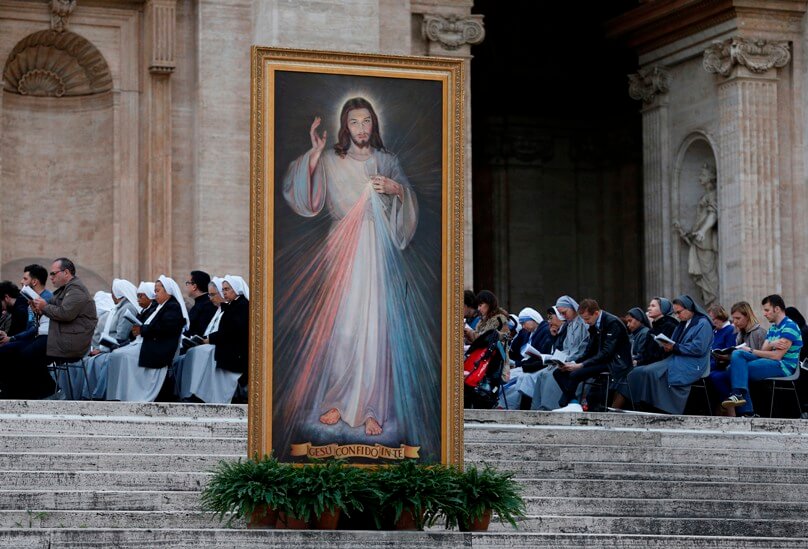
This year, in a fit of spiritual panic, I announced to my family that we’d be praying the Divine Mercy novena. It started on Good Friday and culminated on Easter Saturday, and by gum, we did it. At least, we stopped after Easter Saturday. There may have been some funny business around Day 6, but we started together and ended together, and it was better than doing nothing.
Or was it? Boy, that is a tricky novena. I love saying, “For the sake of His sorrowful passion, have mercy on us and on the whole world.” Begging for mercy (and reminding ourselves where to find the font of all mercy) is something sorely lacking in modern spirituality. We tend to feel that we are doing the Holy Spirit a favour by showing up. In truth, He’s glad to see us, but the favor is all His.
So as I say, I liked all that begging for mercy. I needed it. And I loved the end part, where you say three times, “Holy God, Holy Mighty One, Holy Immortal one, have mercy on us and on the whole world.” But I could have done without . . . the rest of it.
There’s a children’s book where a bunny wants to decorate his grandmother’s cake with his favorite candy: Red Hot Marshmallow Squirters. And the Divine Mercy novena is the literary equivalent of what I imagine Red Hot Marshmallow Squirters to be: squashy, gooey, and intense, but not in the good way. The language is an unpleasant combination of flowery emotionalism and jarring harshness, clunky and awkward in parts, byzantine and formal in others. One member of my family got pretty hung up on the word “abyss,” which kept turning up, as in “Today bring to Me the souls who are detained in purgatory, and immerse them in the abyss of My mercy.”

So let’s start with that word, “abyss.” It almost always has negative connotations, as in “abysmal” (leading this particular family member to riff on the novena: “Welcome us, Lord, into the horrifying dungeon of your kindness! Allow us to fall into the miserable trap of your goodness!”). Originally, the word is derived from Greek, a-byssos, meaning “bottomless.” The word “abyss” has always been associated with bad bottomless things — Hell, for instance, or chaos– with a few exceptions. Occasionally, it seems to have been used to mean simply “endless” or “fathomless,” and that’s how the translator of the novena used it. The well of Christ’s mercy never goes dry and has no limits. That kind of abyss.
So, what could be good about hearing a jarringly archaic word? It reminds us that the Church has been around far longer than us and our sensibilities. This “bigger than me” reminder is almost always useful. It’s a good dose of humility to know that the Church has weathered worse storms than the one I’m currently grousing about; the Church has ministered to people with more urgent needs than the ones I’m currently chafing under; and the Church cares ardently for people who have nothing in common with me but a need for God’s love. Jesus’ love is very much about me, in my specificity, but it’s also very much about everyone else, and every time else, and every circumstance else. So “abyss” is a jarring word, but there are benefits to being jarred out of a self-centered notion of the faith.
It’s also possible that the word “abyss” and other clunky phrases in the novena were simply translated poorly, and then stuck, in a way that only Catholic devotions can stick. This, too, shouldn’t be a deal-breaker when we approach spiritual matters. When we demand that every last little thing be calibrated to our aesthetic liking, we run the risk of worshipping aesthetics, rather than the Lord they’re meant to honor. So, yes, make adjustments when necessary. If a better translation is available, by all means use it! But don’t be such a precious butterfly that you simply can’t abide to alight on something that tickles you this way instead of that way. Keep on fluttering, and you’ll never get to the nectar.
Heck, the Divine Mercy visionary St Faustina herself was horribly crushed when she saw the first rendition of the Divine Mercy image that the Lord told her to commission. She actually cried when she saw it; but apparently Jesus told her, “Not in the beauty of the colour, nor of the brush lies the greatness of this image, but in My grace.” In other words: It’ll do. It never was about the picture. There’s no such thing as a picture of Jesus that conveys everything that Jesus is. But the one that we have has done the trick for countless thousands of people, because Jesus is who He is.
We need plenty of help in coming closer to Christ. We should try to find devotions that speak to us, a spirituality that makes sense to us, and a medium that we can respond to. But there’s something to be said for remembering that none of it is good enough. Any image, any novena, and kind of spirituality falls short of the splendour of Christ. If we think we’ve found the one that says it all, then that means we’re settling for something far less than what Christ really is.
And if we come across some particular prayer or style of worship that is truly abysmal — well, it’s only nine days.
